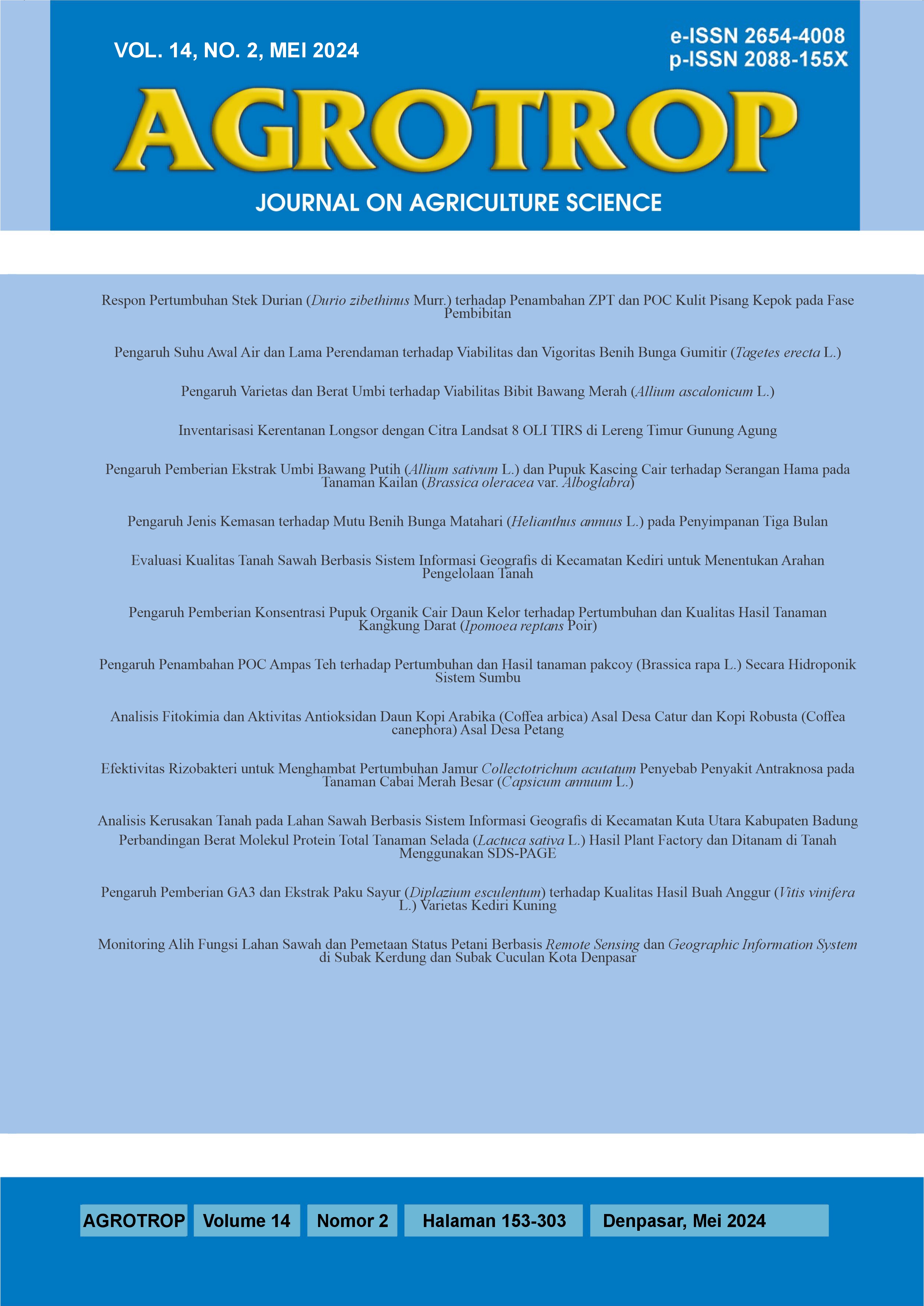Pengaruh Pemberian GA3 dan Ekstrak Paku Sayur (Diplazium esculentum) terhadap Kualitas Hasil Buah Anggur (Vitis vinifera L.) Varietas Kediri Kuning
Abstract
Effect of GA3 and Vegetable Spike Extract (Diplazium esculentum) on the Yield Quality of Grape (Vitis vinifera L.) Kediri Kuning Variety. This study aims to determine the effect of vegetable fern extract solution on the quality of grapes of Kediri Kuning variety and the concentration that can improve the quality of grapes. This research uses RAK (Randomized Group Design) with the treatment of vegetable fern extract consisting of 5 levels with 5 replicates, namely P0 = Control, PG = GA3 500 ppm, PS25 = 25%, PS50 = 50%, PS75 = 75%. The results showed that the treatment of vegetable fern extract solution gave an influence on the variables of titratable acid content, fruit bunch length, number of seeds per fruit, vitamin c content, antioxidant properties content, and seed weight per fruit, tannin content. Dipping the vegetable fern extract solution in the stadia before flower blossom can improve the quality of Kediri Kuning grapes, seen in titratable acid content, fruit bunch length, number of seeds per fruit, weight of seeds per fruit, vitamin C content, antioxidant properties, and tannin content. The concentration of 50% vegetable spike extract is able to provide the best results and quality to improve the quality of Kediri Kuning grapes.
Downloads
References
Cassanova, L., R. Cassanova, A. Moret, & M.Agusti. (2009). The Application of Gibberelic Acid Increased Berry Size of “Emperatriz” Seedless Grape. Spanish J. Agric. Res. 7(4): 919-927
Cirami RM, EJ Cameron, & PR Hedberg. (1992). Special Culture Methods for Tablegrapes on Coombe BG and PR Dry. (Eds) Viticulture vol.2 Practices. Pp 279-327
Extention. (2015). Using Gibberelic Acid to reduce cluster compactness in grapes. www.extention.org/pages/3168 (download 15 agustus 2022).
Pardal. (2001). Pembentukan Buah Partenokarpi Melalui Rekayasa Genetik. Balai Penelitian Bioteknologi Pangan. Bogor. Jurnal Agrobio 4 (2): 45-49.
Prihatman, K. (2000). Budidaya Pertanian: Anggur. Sistem Informasi Pembangunan di Pedesaan, BAPPENAS.Pustaka Mina. Jakarta.
Salisbury, Frank B & Cleon W Ross. (1995). Fisiologi Tumbuhan Jilid 1. Bandung: ITB
Serrani, J.C., Fos, M., Atarés, A. & GarcíaMartínez J.L. (2007). Effect of gibberellin and auxin on parthenocarpic fruit growth induction in the cv. Micro-Tom of tomato. J. Plant Growth Regul., 26 : 211–221.
Widodo, W. D. (2002). Aktivitas Hormon Endogen dalam Buah Anggur Muscat of Alexandria Muda Tanpa Biji Hasil Induksi Antibiotika. Bul. Agronomi, 30(3), 92- 99.
Wijayanto, T., Yani, W. O. R., & Arsana, M. W. (2012). Respon Hasil dan Jumlah Biji Buah Semangka (Citrullus vulgaris) dengan Aplikasi Hormon Giberelin (GA3). J. Agroteknos., 2(1), 57-62.
Zain, A. R., Basri, Z., & Lapanjang, I. (2015). Pembentukan Buah Terung (Solanum melongena L.) Partenokarpi melalui Aplkasi berbagai Konsentrasi Giberelin. Jurnal Sains Dan Teknologi Tadulako, 4(2)











